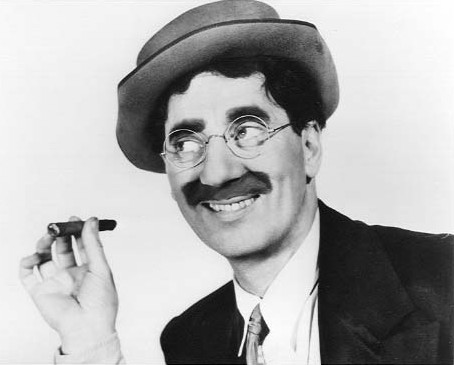Invited to a Halloween party a few years ago and at a loss for a last-minute costume, I put on my most raggedy suit, bought a cigar, applied three strips of greasepaint, and walked in the door as Groucho Marx. If you think you know where this is going, don’t worry – everyone else dressed in costume too. Unfortunately, I thought Groucho would be as iconic and recognisable as Elvis or Dracula, and not one of my educated, middle-aged neighbours had heard of him.
Of course we were in Ireland, where cultural touchstones can be different, but more and more North Americans, I find, have no familiarity with classic movies either. I rarely see them in my local DVD stores or libraries, with a few predictable exceptions: a John Wayne movie or two for elderly men, a now-colourised musical for women, and the inevitable Three Stooges. Exceptions like It’s a Wonderful Life loop endlessly in holiday marathons until they become white noise, no matter how relevant in this time of bank failures.
Perhaps this is understandable; most people these days find the conventions of black-and-white movies as alien as Kabuki theatre, familiar only from decades of countercultural spoofing. Many times I have eagerly attended the rare revival, from Dark Victory as a teenager to Metropolis last year, only to cringe when the dramatic scenes reduced the audience to horse laughter. Young people might do well to explore old movies, though, for as we enter a time of austerity they might turn out more relevant and prophetic than anyone realises.
I don’t mean science fiction films from that era, with their now-hilarious predictions of flying cars and domed cities. Nor do I mean recent science fiction, which in the 1970s took the same apocalyptic turn as our religion and our politics, until by now most rental stores have a single section for “science fiction/horror.”
In defence of Zombie Apocalypse movies, our society is facing some serious problems. We have built a world where almost everything depends on fossil fuels — cars, air travel, trucking, shipping, heat, electricity, plastics, and fertiliser. We use more fossil fuels every decade, yet their supply is limited, and many experts, including the U.S. Army, predict a crunch in the next several years. The coming decades will probably bring more outages and shortages, along with weirder weather and economic shocks, problems that will all feed on each other. Energy alternatives like bio-fuels, nuclear, wind and solar might allow us to live with the per capita energy of 80 years ago rather than 180 years ago, but nothing will spare us from having to make do with less.
Post-apocalyptic fiction, though, assumes everything will disappear, overnight, ridding the world of the people we don’t like and leaving us with all the world’s toys. The reality will probably be less horrific and cinematic; fossil fuels will probably abate over decades, and the greatest danger will be enforced simplicity for millions of people mentally unprepared for it.
That’s where movies come in – and television and other media, but I’m focusing on movies. Most of us spend most of our waking lives staring at glowing rectangles, and we weave our mental landscape of the world from media images like birds building a nest from scraps. When I read accounts of Thermopylae I still see 300, and even when I read Gandhi’s original writings I still picture Ben Kingsley.
For movies to help us prepare for our real future, though, it has to show us what such a world could look like, and neither Star Trek nor Zombie Apocalypse fiction help us show people struggling to pay the mortgage, irrigate the crops and hitch a ride to town. We do have thousands of movies that do show us this more limited future, though, because they were made in a more limited past.
Some films of the 1930s and 40s included Busby Berkeley-style fantasies, of course, but most had to show people a world they recognised, and in the details of backgrounds and dialogue we can glimpse a very different America. For one small example, take 1932’s Grand Hotel: Joan Crawford’s character eats only one meal a day, the most she can afford, while Lionel Barrymore’s dying character wants to treat himself to the finest luxuries the hotel can offer, “my own bathroom, like rich people.”
Or take the scene in 1943’s Tender Comrade where Ginger Rogers describes to Robert Ryan the kind of normal life they would have when he returns from the war: a garden where they could grow their own food, with chickens in the yard. It’s not the kind of dialogue we’re likely to see in a war movie today, but it should be. And when our soldiers return, they will have to rebuild their old lives, reboot their marriages and rediscover their children – a story Hollywood told well in 1946’s The Best Years of our Lives.
As another example, take King Vidor’s 1934 film Our Daily Bread: a young couple can’t pay their rent, and neither can most of their friends. They have inherited some land but can’t pay the taxes, for no one is around to cultivate the property. Someone realises the two problems could solve each other; they and their friends can move to the land, build a new life and split the profits from the farm.
I haven’t seen many films about working people trying to get health care — unless I watch 1938’s The Citadel. More people must care for elderly parents, but I don’t see many films dealing with the problems that causes, outside of 1937’s Make Way for Tomorrow. And has any recent film showed the down-and-out as heroes, as in Meet John Doe, The Grapes of Wrath or I Am a Fugitive from a Chain Gang?
To most people I talk to these days, old movies seem hopelessly corny and unrealistic – and obviously some had dated references, poor dialogue, or simply have not aged well. Their depictions of African-Americans appropriately offend modern sensibilities, as does the sight of white actors playing ethnic roles. I don’t recommend them if you’re trying to quit smoking, either; even in The Citadel, one surgeon hands another some cigarettes, saying “they’ll calm your nerves.”
Classic films also treated courtship and language with a gentleness that seems strange to us today, now that our mass media have spent four decades celebrating every new broken taboo as a victory against The Man. Are films with graphic sex and gore, however, more realistic? Is that what your life is like?
In fact, movies of the 1930s and 40s, despite their innocent image, show a grimmer world than we are used to seeing. Frank Capra’s movies have become synonymous with Norman Rockwell Americana, but their bright moments were powerful because they were surrounded by darkness, their decent characters – John Doe, George Bailey — framed, harassed and pushed to suicide and madness.
Ironically, I grew up with old movies because of this misconception; for conservative Christians in the 1970s and 80s, classic movies made safe entertainment, so my brothers and I grew up knowing Humphrey Bogart and Jimmy Stewart the way other children know rappers or wrestlers. We passed every supper with trivia contests, with games our parents and grandparents had created. In one game we were given two actors – say, Charlie Chaplin and John Wayne – and had to link them with the shortest possible number of co-stars. These days I’m sure someone has a web site and algorithm to tell you instantly, but we had to calculate on the spot that the answer was one: Paulette Goddard.
Yes, it’s the Kevin Bacon game; years later a bunch of college students patented it, marketed the idea and gained fame and fortune. No, I’m not bitter.
In another game, which we called Rotunda, we started with a film and two co-stars – say, Claude Rains and Jimmy Stewart – and then each of us took turns bouncing through co-stars, from Jimmy Stewart/Cary Grant in The Philadelphia Story to Cary Grant/Mae West in She Done Him Wrong and so on. The goal of the game was to make your way back to the first actor you named, but to anticipate several moves ahead, so that only you, and no one else, would reach the crucial link to Claude Rains.
This love of movies stayed with me over the years; I worked as a film critic for a newspaper chain for a while in my twenties, which sounds like a dream job until you realise how many bad movies you need to sit through. Depressingly, I found that the quality of movies has deteriorated over time; take the best films of any year, and they do not outweigh the products of even a single month of, say, 1941.
Of course such a sweeping and subjective statement will not match everyone’s tastes, and of course film technology keeps improving, each decade bringing a new kind of animation, CGI, 3-D or some other way to wow us. Few films today, though, seem to rely on great stories; they have become spectacles, as silent movies were, rather than well-written plays. Moreover, any one of them cost enough to make a hundred films like The Thin Man or The Maltese Falcon, even accounting for inflation. Few filmmakers today, rolling in wealth and with the godlike power to create whole worlds onscreen, do as much as John Huston or Woody Van Dyke did with a cardboard set.
And this brings us back to living on less. When the Great Depression hit, movies shifted away from the big-budget fantasy spectacles of the 1920s into more modest and realistic fare. In part they were responding to the demands of newly invented talkies, but also to the desires of an increasingly desperate and politically radical America. Hollywood saw an intellectual movement – imagine! – of writers and directors determined to tell useful stories by and for ordinary people. American films have never been more well-written or resonant than in the 1930s and 40s, because they have never been more gently and consciously populist.
Such ideals drew accusations of Communism even then, and some of those writers and directors did become entangled in the misguided intellectual causes of the 1930s. “A surprising number,” though, write authors Paul Buhle and Dave Wagner in their book Radical Hollywood, “came straight out of Middle America and made their choice on old-fashioned moral grounds.” There is a reason old movies are so sentimentally cited by Glenn Beck and Pat Robertson as symbols of a better America, and why the growing neo-conservative movement in the 1970s asked an old B-movie star to be their figurehead.
Movies and other media have become spectacles again, and as we move into something far greater and deeper than a Depression, I long to see well-written, idealistic stories about regular people coping with the long emergency.
I want to see films for all ages, devoid of hip countercultural irony. I want to see low-budget teleplays in which today’s equivalent of Mickey Rooney and Judy Garland put on a show to raise money to build allotments in the old park, a new series of Dead End Kids movies in which modern versions of Tommy and Milty cajole the neighbourhood association to allow pigs in the vacant lot.
With a future this severe bearing down on us, movies might seem like small potatoes; if we do face a future of widespread poverty, of course, we should all attend to fundamental human needs, and save the old lady rather than the Mona Lisa. But few things can stick in the thoughts of masses of people as well as movies and television; when I referred to a “Star Trek future” or a “Zombie Apocalypse,” you knew just what I meant.
And they are one of the last things we do in community. I took my seven-year-old to see Buster Keaton’s The General at a rare showing yesterday, and while she chuckled when I showed her clips on YouTube, we had tears in our eyes laughing with an auditorium of people. It felt like a good football game or a revival tent, with waves of emotion rippling over a crowd, and for a brief moment in the darkness you are reminded that we’re all in this together.





7 comments
D.W. Sabin
The most effective defacto censorship in modern history has been that of the American cinema, big screen and television of the last 40 years. Despite it, there have been some miraculous films emerge but the general record has been less than inspiring for a culture which seems to thrive on self-congratulation.
When one inhabits a realm of noise, listening becomes more important even though one wishes to simply blot out the noise.
Independent Cinema , in all its forms is one of those places where one can search out and find imperfect beauty. It records the current life in all its quixotic and tawdry abundance or consternating contradictions.
But I’m biased. My leetle eldest keed and her fiance just won the Marc’ Aurelio Award for best documentary in the Extra Section as well as the EnelCuore award for their latest film “Girl Model” …an essay on human commodification…. at the Rome Film Festival.
There is a world of human story to be told against the tide of the reigning Vicarious Agora. Independent film folks are tilling a deep furrow.
Rob G
The vast majority of films that are any good these days are made outside of Hollywood; that is they are either American indie pics or foreign films. It has become quite obvious, even to the casual observer, that Hollywood is largely in the business of business nowadays — they are making products with little or no moral or artistic merit with the sole intent of turning a profit. This accounts for the endless number of bad remakes, “reboots,” comic-book films, cheap horror flicks, etc.
Anymouse
“We can expect movies of the quality of those directed by Ford and Capra and Hawks when at least some of these conditions return.”
I echo this.
Tony Esolen
A fine article — and you have my sympathy. A couple of thoughts:
The old filmmakers and actors, as you suggest, came from ordinary America. They all knew what hard physical labor was like, having done plenty of it, or having watched their parents do it. They knew the insides of churches and synagogues. They remembered worship, remembered it in their hands and their knees, even when they wandered far from the fold. They grew up thinking that a movie would be like a play, or like what Italians would see in their opera houses. They didn’t have color film at first, so they learned to focus intently upon the human face. They still believed in goodness, and had a rich repository of ideas for thinking about good and evil. They had not yet decided that men and women were interchangeable. Their minds held echoes of profound words, from Scripture, maybe from Shakespeare or another poet now and then. The men who acted in the movies knew war by experience or by the testimony of close friends, or close male relatives. When they thought of music, they heard ragtime or jazz or genuine folk melodies or Puccini or old hymns. We can expect movies of the quality of those directed by Ford and Capra and Hawks when at least some of these conditions return.
Anymouse
I might also suggest something like Only Yesterday, although I have not watched it. I have heard good things about it and seen the trailers.
John Gorentz
Why does it have to be American movies? You can find some of what you want in Russian movies of the socialist realism type, some of which are quite good in spite of the censorship under which the filmmakers worked (which has a lot in common with the self-censorship under which American filmmakers work now, but which produced better movies (as well as some real dogs)). There are movies in which the change in attitudes toward the lowly potato is used to show that the post-war generation had lost its way. But food in general is often used to make points that would make no sense to Americans, except perhaps to those who know about the Great Depression, and maybe not all of those. But those are things people ought to know about. (I watch at least 20 minutes worth of Russian movies almost every evening. Today’s fare included a bit of Solaris that I’ve seen for the umpteenth time, and a re-watching of “July Rain” with my wife, a movie I learned about quite recently. My wife watches these movies with me if they have English subtitles, and I understand a lot more of the dialog myself if they have them. I don’t happen know of any movies from the 30s and 40s that I’d recommend, though, even though I’ve tried a little bit of Eisenstein.)
BTW, you don’t have to be a socialist to enjoy socialist realism. I’m a tea-party sympathizer myself and as somewhat of a communitarian am one hundred percent opposed to the welfare-police state.
Anymouse
The problem is that it will really take this new society with less physical energy to create these new films. People like Isao Takahata have produced many films, (which I have unfortunately not found the opportunity to see) but he grew up in the Japan of the 1940’s. None of the young directors can remotely match him in terms of content, because they have all lived in the new Japan.
Comments are closed.